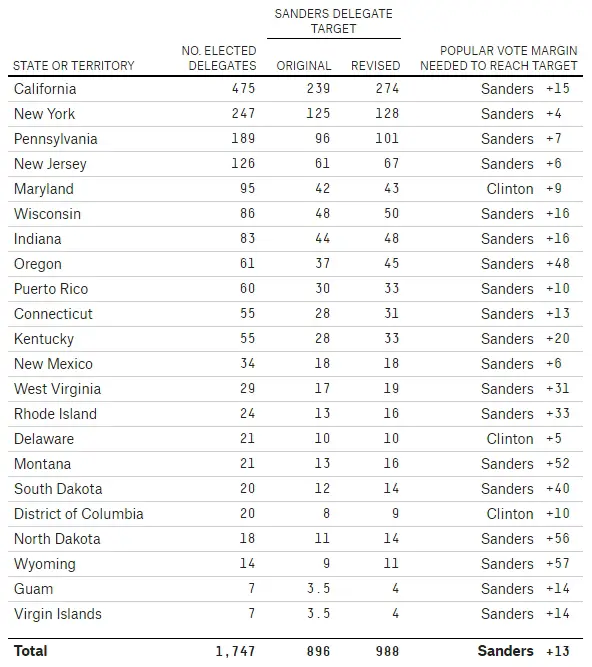We like charts. But since most of the excitement (and intrigue) has been on the GOP side, we haven’t had a chart to play with on the Dem side. Now we do, thanks to Nate Silver, of FiveThirtyEight.
Silver says, “It’s Really Hard To Get Bernie Sanders 988 More Delegates,” but it’s not impossible.
If you’re a Sanders supporter, you might look at the map and see some states — Oregon, Rhode Island, West Virginia, Montana and so forth — that look pretty good for Sanders, a lot like the ones that gave Sanders landslide wins earlier in the campaign. But those states have relatively few delegates. Instead, about 65 percent of the remaining delegates are in California, New York, Pennsylvania, New Jersey and Maryland — all states where Sanders trails Clinton in the polls and sometimes trails her by a lot.
To reach a pledged delegate majority, Sanders will have to win most of the delegates from those big states. A major loss in any of them could be fatal to his chances. He could afford to lose one or two of them narrowly, but then he’d need to make up ground elsewhere — he’d probably have to win California by double digits, for example.
Sanders will also need to gain ground on Clinton in a series of medium-sized states such as Wisconsin, Indiana, Kentucky and New Mexico. Demographics suggest that these states could be close, but close won’t be enough for Sanders. He’ll need to win several of them easily.
OK, so it’s not likely. . .but it’s possible. And here’s the chart to follow. It’s important to note that the chart was done before Wisconsin—and Bernie got exactly what he needed there.
Silver admits that this chart is pretty much wishful thinking, but at least we have something to follow, to see how well, or how badly, Bernie does.
The good news for Sanders is that this scenario would represent such a massive sea-change that superdelegates really might have to reconsider their positions. You might even say it would require a revolution, a profound rejection of Clinton and the status quo.
Bernie’s not giving up. In an interview on MSNBC, Sanders said—
“Here is our path to the nomination. First of all, we have extraordinary momentum. We have won six out of the last seven caucuses and primaries. We’ll see what happens today in Wisconsin. We’ll see what happens shortly in Wyoming. And we have won all of those elections up to now by landslide victories.. . .
“And I’ll tell you something else. As I think Democrats and super delegates look at the political landscape, what they are seeing is, in poll after poll, Bernie Sanders does a lot better against Donald Trump than does Hillary Clinton. . . And I think that when super delegates look at the reality of which candidate is the strongest against Republicans, I think you’re going to see a lot of the super delegates coming up with us.”
This path, however, is a difficult row to hoe. Even liberal MSNBC thinks so.
The entire Sanders plan hinges on winning New York. If Sen. Sanders doesn’t win in New York, then Pennsylvania, and New Jersey, he will not only be impossibly behind in pledged delegates, but he will also lose the argument that he is the candidate who deserves to be the Democratic nominee. After Wisconsin, there are no more open primaries and caucuses until May 3.
As noted, Bernie’s path assumes he’ll win New York. Nate Silver concedes it’s a problem.
I assumed Sanders would narrowly win New York, for instance, even though he’s trailed Clinton by margins ranging from 21 to 48 percentage points in recent polls there.
Donate Now to Support Election Central
- Help defend independent journalism
- Directly support this website and our efforts

